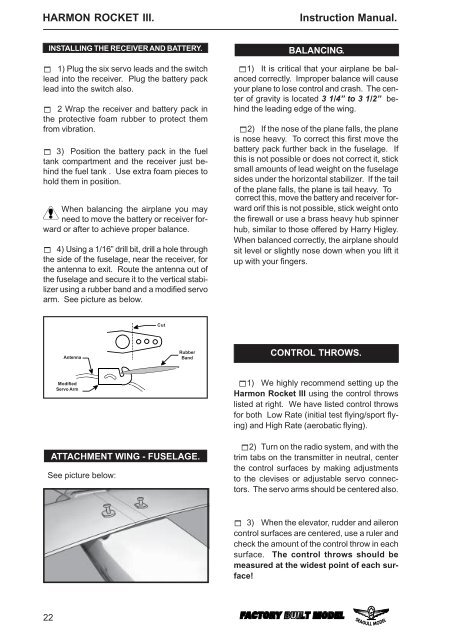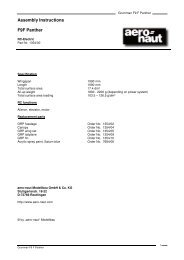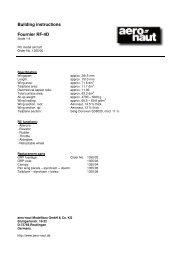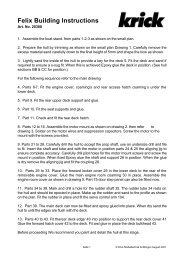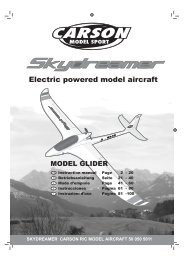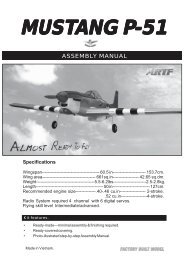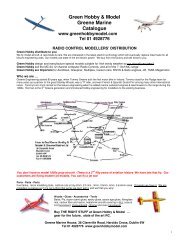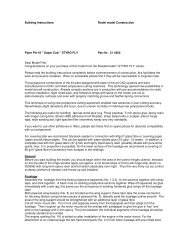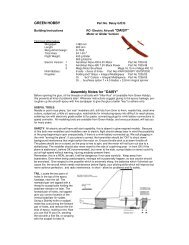HARMON ROCKET III - Green Hobby & Model
HARMON ROCKET III - Green Hobby & Model
HARMON ROCKET III - Green Hobby & Model
You also want an ePaper? Increase the reach of your titles
YUMPU automatically turns print PDFs into web optimized ePapers that Google loves.
<strong>HARMON</strong> <strong>ROCKET</strong> <strong>III</strong>. Instruction Manual.<br />
INSTALLING THE RECEIVER AND BATTERY.<br />
! 1) Plug the six servo leads and the switch<br />
lead into the receiver. Plug the battery pack<br />
lead into the switch also.<br />
! 2 Wrap the receiver and battery pack in<br />
the protective foam rubber to protect them<br />
from vibration.<br />
! 3) Position the battery pack in the fuel<br />
tank compartment and the receiver just behind<br />
the fuel tank . Use extra foam pieces to<br />
hold them in position.<br />
When balancing the airplane you may<br />
need to move the battery or receiver forward<br />
or after to achieve proper balance.<br />
! 4) Using a 1/16” drill bit, drill a hole through<br />
the side of the fuselage, near the receiver, for<br />
the antenna to exit. Route the antenna out of<br />
the fuselage and secure it to the vertical stabilizer<br />
using a rubber band and a modified servo<br />
arm. See picture as below.<br />
BALANCING.<br />
!1) It is critical that your airplane be balanced<br />
correctly. Improper balance will cause<br />
your plane to lose control and crash. The center<br />
of gravity is located 3 1/4” to 3 1/2” behind<br />
the leading edge of the wing.<br />
!2) If the nose of the plane falls, the plane<br />
is nose heavy. To correct this first move the<br />
battery pack further back in the fuselage. If<br />
this is not possible or does not correct it, stick<br />
small amounts of lead weight on the fuselage<br />
sides under the horizontal stabilizer. If the tail<br />
of the plane falls, the plane is tail heavy. To<br />
correct this, move the battery and receiver forward<br />
orif this is not possible, stick weight onto<br />
the firewall or use a brass heavy hub spinner<br />
hub, similar to those offered by Harry Higley.<br />
When balanced correctly, the airplane should<br />
sit level or slightly nose down when you lift it<br />
up with your fingers.<br />
Cut<br />
Antenna<br />
Rubber<br />
Band<br />
CONTROL THROWS.<br />
Modified<br />
Servo Arm<br />
!1) We highly recommend setting up the<br />
Harmon Rocket <strong>III</strong> using the control throws<br />
listed at right. We have listed control throws<br />
for both Low Rate (initial test flying/sport flying)<br />
and High Rate (aerobatic flying).<br />
ATTACHMENT WING - FUSELAGE.<br />
See picture below:<br />
!2) Turn on the radio system, and with the<br />
trim tabs on the transmitter in neutral, center<br />
the control surfaces by making adjustments<br />
to the clevises or adjustable servo connectors.<br />
The servo arms should be centered also.<br />
! 3) When the elevator, rudder and aileron<br />
control surfaces are centered, use a ruler and<br />
check the amount of the control throw in each<br />
surface. The control throws should be<br />
measured at the widest point of each surface!<br />
22


